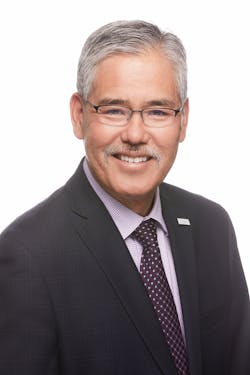Best Practices: Autonomous Mobility
Join Randell Iwasaki, Kristina Holcomb and Jay Hietpas in a Virtual Roundtable, sponsored by Bestmile, Tuesday, August 28, 3:00 EDT. Following the roundtable, you can view the archived webinar at https://event.webcasts.com/starthere.jsp?ei=1203324&tp_key=3c8d21aed1.
Walnut Creek, Calif.
Randell H. Iwasaki
Executive Director
Contra Costa Transportation Authority
It’s true: autonomous vehicles do not need a driver. That said, lots of other "drivers" are needed to successfully incorporate autonomous technology into a transportation system. Most notably we need drivers of innovation, legislation, and collaboration. The Contra Costa Transportation Authority (CCTA) fully understands what it takes to move autonomous technology into the future. With public and private partnerships, and our ability to guide legislation in a direction that promotes innovation, CCTA is curating a landscape ready to accept and integrate autonomous vehicles.
As the long-range transportation planning agency for Contra Costa, our agency prepares a Countywide Transportation Plan approximately every four years. For the most recent plan, our agency conducted extensive public outreach to find out how we could best serve the needs of the county. We received more feedback for this particular cycle, than we had in all of our previous efforts combined. A common theme was that citizens were interested in using transit to get to their destinations, but the lack of sufficient first/last mile connections was a big obstacle to transit use. Increasing transit ridership is key to our agency’s long term vision of managing congestion and facilitating a multi-modal network that provides options for all members of our community.
After a search for a solution, CCTA launched our shared autonomous vehicle (SAV) pilot project focused on testing electric, low-speed, multi-passenger autonomous vehicles manufactured by Easymile. These vehicles lack a steering wheel, brake pedal, and accelerator. The program launched in 2016, upon passage of Assembly Bill 1592 by the California State Legislature which allows CCTA to conduct testing of shared autonomous vehicles. In order to fully and properly run simulations of autonomous vehicles, CCTA and its partners needed a privately-owned, fully-secure, city-like facility. As luck would have it, CCTA did not have to look far for such a testing space.
GoMentum Station — a 5,000 acre decommissioned naval weapons station located in Concord, California — is the largest secure autonomous vehicle testing facility in the United States, complete with paved roadways, tunnels, curbs, sidewalks, railroad crossings, potholes and a mini-city. Access to this space allowed CCTA and Easymile to perform initial phase testing in a controlled environment as they worked toward a debut on public streets. In March 2018, after fulfilling the necessary steps with both the U.S. Department of Transportation’s National Highway Traffic Safety Administration (NHTSA) and the California DMV, CCTA obtained the first license in California to test a SAV with no steering wheel or brake pedal on public streets.
Shared autonomous shuttles offer safe, accessible, affordable service that could provide first/last mile transit solutions in office parks, campuses, suburbs, town centers and transit hubs, while easing congestion and reducing harmful emissions. For our particular pilot program, the goal is to operate the SAV’s as a complement to transit – helping our residents bridge the first/last mile that had previously prevented them from utilizing transit. In fact, our regional bus provider, County Connection, and regional light rail provider, Bay Area Rapid Transit (BART), are both partners in the program to help inform how to best serve their systems. The significant milestones met by CCTA’s SAV program to date offer important insight into how shared autonomous vehicles can be fully integrated within an existing transportation system to support existing service.
Lewisville, Texas
Kristina Holcomb
Vice President of Planning and Development
Denton County Transportation Authority
For the past few years, the autonomous vehicle trend has reached a fever pitch with businesses looking for strategic ways to leverage this technology in their business model. Many private companies are investing in or developing driverless technology, which could have an impact on the standard public transportation agency business model and the outlook of the mass transit industry.
At the Denton County Transportation Authority (DCTA), we recognize the benefit of public-private partnerships which enable us to provide more innovative mobility solutions for the many communities we serve. In May 2018, DCTA partnered with the City of Frisco – recently named the fastest growing city in the U.S. – Frisco Station Partners, HALL Group and The Star to form the Frisco Transportation Management Association (TMA) to improve connectivity between several mixed-use developments in Frisco’s “North Platinum Corridor.”
With DCTA already providing on-demand service in Frisco, being a Frisco TMA partner was a natural fit. In addition, DCTA’s mission is aligned with the FMTA’s key focus on mobility solutions such as improving walkability, ride-sharing, connected vehicles (with traffic signal data sharing), and introducing driverless vehicle service between The Star, HALL Park and Frisco Station developments.
Through this partnership, the Frisco TMA works in cooperation with Drive.ai – California-based self-driving company – to launch a pilot program to deploy an on-demand self-driving car service to the City of Frisco offering rides to area employees and residents in self-driving vehicles within a geofenced area comprised of retail, entertainment, office space and multifamily housing.
The initial pilot launched in mid-July 2018 and will operate for six months, beginning with fixed pickup and drop-off locations for 10,000 office employees at HALL Park and The Star entertainment development, with planned expansion into Frisco Station, a large multifamily residential neighborhood. This program is a milestone for North Texas, marking the first-time members of the public will have access to an on-demand, self-driving car service on public roads.
It is an incredible opportunity for DCTA to be a partner in the development and deployment of this autonomous vehicle pilot program. As the need for mobility solutions continues and the expectations of our customers increase, it is critical for our agency to always seek innovative ways to meet the demands of our communities.
Leveraging technology through public private partnerships is a way DCTA can increase operational efficiency, provide more real-time mobility solutions, improve convenience of travel as well as complement existing modes of traditional transit. We also expect to gain some insight on community acceptance of autonomous vehicles and gauge the public opinion of using this mode of service for travel.
The emerging trend of driverless mobility is here and likely to stay. Incorporating innovative modes of transportation should be a consideration for more public transit agency’s vision for the future.
St. Paul, Minn.
Jay Hietpas, P.E.
Connected and Automated Vehicles Director
Minnesota Department of Transportation
Although we are not using these technologies actively in our operations, we are looking at how these technologies can benefit safety and traffic operations in Minnesota. Before we can implement these technologies, we need to make sure they can operate safely in our winter weather environments, and that we understand the limitations in which the technology can work. We started last year by testing a low-speed automated shuttle bus in winter weather conditions. We allowed the public to ride the vehicle, learn how it interacted with pedestrians and bicycles, and ask their opinions about their excitement and fears about the technology. We learned that after the public has a chance to ride the vehicle and learn about the technology, they developed a comfort level.
One of the challenges we see is finding vehicles that can operate safely in our weather conditions. It is already difficult enough for human drivers to drive in snow, ice and sleet, but how does an automated vehicles detect and adjust to these conditions. Automated features are already appearing on some vehicles, for example a Tesla can maintain speed and change lanes in certain environments without the driver touching the steering wheel or pedals. But, the users need to understand the limitations of when this technology works. Just because the technology works well on a freeway on a nice day, doesn’t mean that the user should operate the system in a blizzard, and expect the vehicle to perform the same as it does in warm weather conditions.
Lombard, Ill.
Yann Leriche
CEO
Transdev North America
The momentum of the autonomous vehicle revolution continues to roll through North America. As transit authorities create plans for designing and integrating their own unique mix of current and new mobility solutions, autonomous shuttles are blazing the way as the newest mode in deployments of various types.
Transdev has multiple autonomous shuttle deployments, following our philosophy that it is best to start small, learn fast and scale smart. Implementing groundbreaking technology creates new challenges and issues that makes continuous learning a critical element of any AV shuttle program.
Working with our client in Gainesville, Fla., our AV is running in mixed traffic, transporting students from a large campus to downtown and back. We are helping our client understand if AVs can—as we believe—truly supplement existing, traditional transit choices. In Jacksonville we will help our client explore if AVs can update an expensive and bygone people-mover infrastructure and offer equally sustainable solutions. This pilot is interesting because it transforms a fixed route raised track system into a more flexible system that leaves the confines of the infrastructure to circulate into neighborhoods and business parks, expanding the footprint of the service. Near Fort Myers, in Babcock Ranch, we will see if AVs are ready to handle the full mobility needs of a town of 50,000 residents, connecting people to destinations within the community and even delivering packages utilizing AV technology. Babcock Ranch hopes to combine an autonomous network with other forms of transportation, creating a true Mobility as a Service offering to its residents.
In Rouen, France (in Normandy) we are conducting an ambitious AV pilot with our client and multiple partners, in which our on-demand vehicles transport people to and from key transit hubs, in mixed traffic along three distinct loops.
We are putting the technology in place to succeed in small use cases, while learning and preparing to expand service intelligently, while taking into account feedback from all users and stakeholders. We are reconfiguring, expanding, and modifying multiple dimensions based on the immediate feedback of operations, tech and marketing teams, plus vehicle manufacturers, and passengers. Our experience thus far has taught us some valuable lessons:
- Accept that you have to learn to crawl, then walk, then run.
- Not all Autonomous Vehicles are equal. Consider whether you want “smart vehicles” with self -contained technology able to navigate their environment independently , or a “smart” environment where less rigorous AV technology is supplemented by V to X sensors making it more economical (but less flexible) to provide a multiple vehicle service.
- Be sure to check the actual on the-road time of the vehicles you choose. There is a lot of hype and many new manufacturers who promise a lot but have yet to log on the road time and execute testing that proves they can deliver consistent performance.
- Think of AVs as supplementing connecting, expanding -- not necessarily replacing routes. Why? They still travel slow, they stop when they are in situations that are unfamiliar to them, and have different kinds of challenges in intersections. Situations like campuses, convention centers, planned communities and roads with less traffic that connect people to transit hubs are strong candidates. Today’s generation of vehicles still need to travel on relatively unencumbered roads.
- Electric vehicles have their own unique set of challenges. Battery life is impacted by heat, and batteries require recharging at varying intervals (depending on the level of activity) and also require their own infrastructure.
- Develop a rigorous check list to review with potential vehicle manufacturers. A private sector partner like us doing multiple trials with multiple vehicle types can be very helpful here.
- AVs do not yet work without a safety operator. Local regulatory compliance and certifications, vehicle capability, operating environment, passenger e-hailing systems make up just some of the auxiliary services and operating features required to operate an AV service.
- Keep your focus on the quality of the passenger experience at every step. The technology is obviously key, but the service has to work for passengers dealing with their everyday mobility needs. We capture passenger feedback on an ongoing basis.
- Remember the human cost. There is still a lot of human management and operational know-how involved in deploying AV systems today. There are many pieces of AV systems that require regular maintenance, and companies that have had success in the R&D environment can be unprepared for the repetitive nature of regular operations. We are hiring several operators, deployment engineers and dispatchers this year just to manage our relatively small test fleet.
Autonomous Vehicle shuttles hold promise for being well-integrated into the transit systems of tomorrow. While today we crawl, soon we will walk and then run – but it all starts first with understanding the technology and designing its best use applications in a transit authority’s mobility ecosystem. Ensuring that operations, marketing, technology and other key departments all fully collaborate is key to success, as is ensuring that your integrated teams are committed to continual learning, experimenting and adapting along the way.




